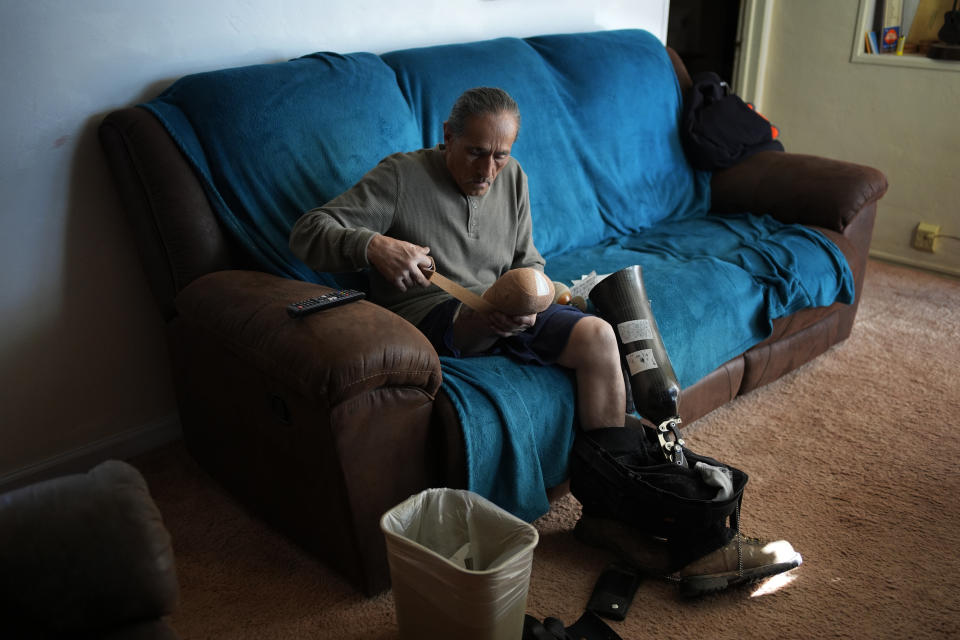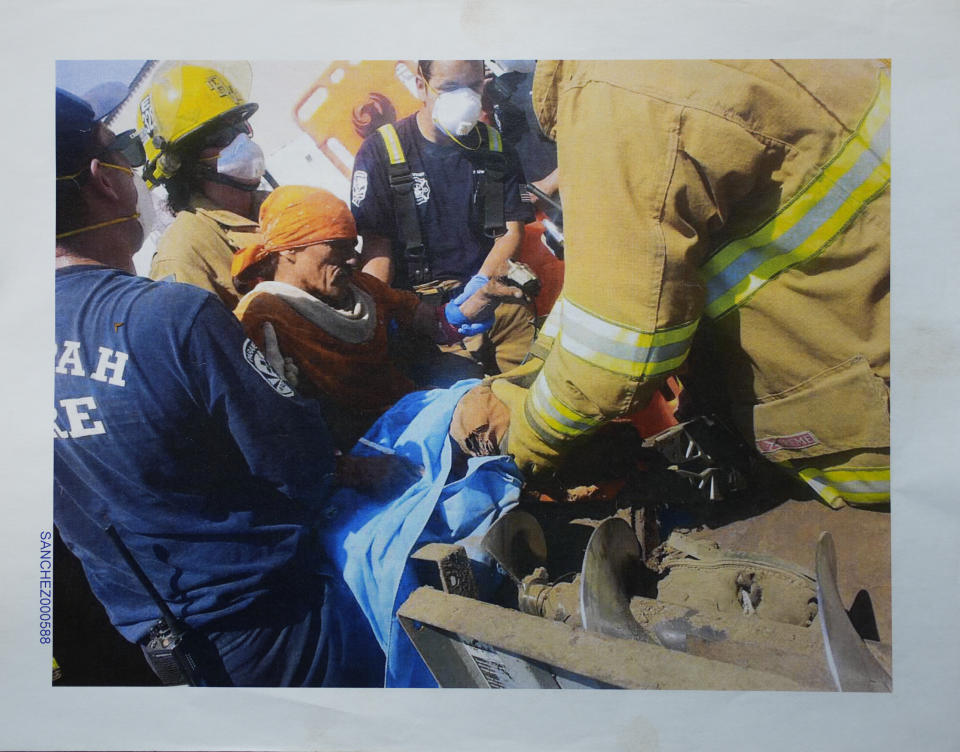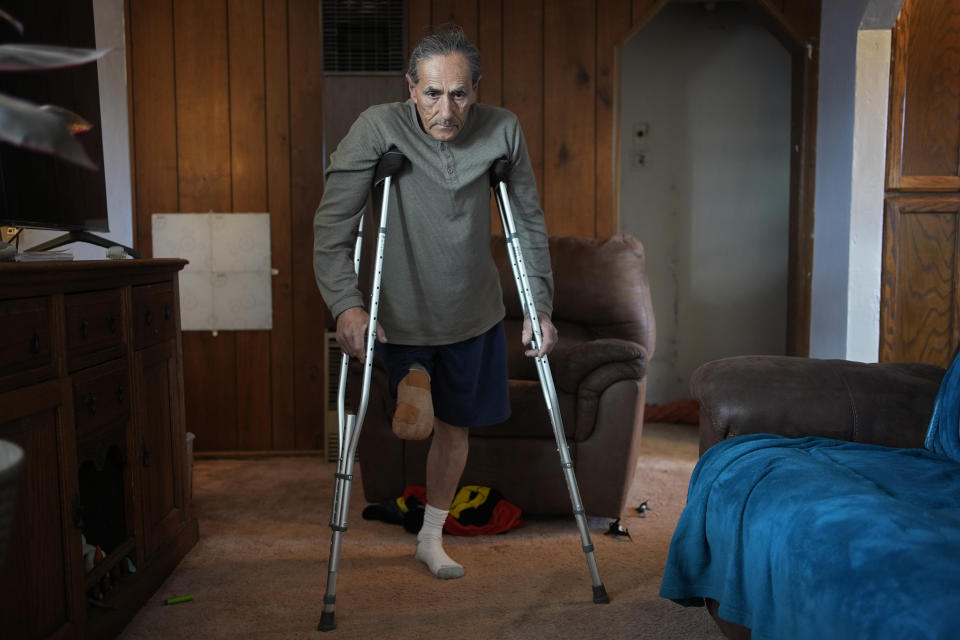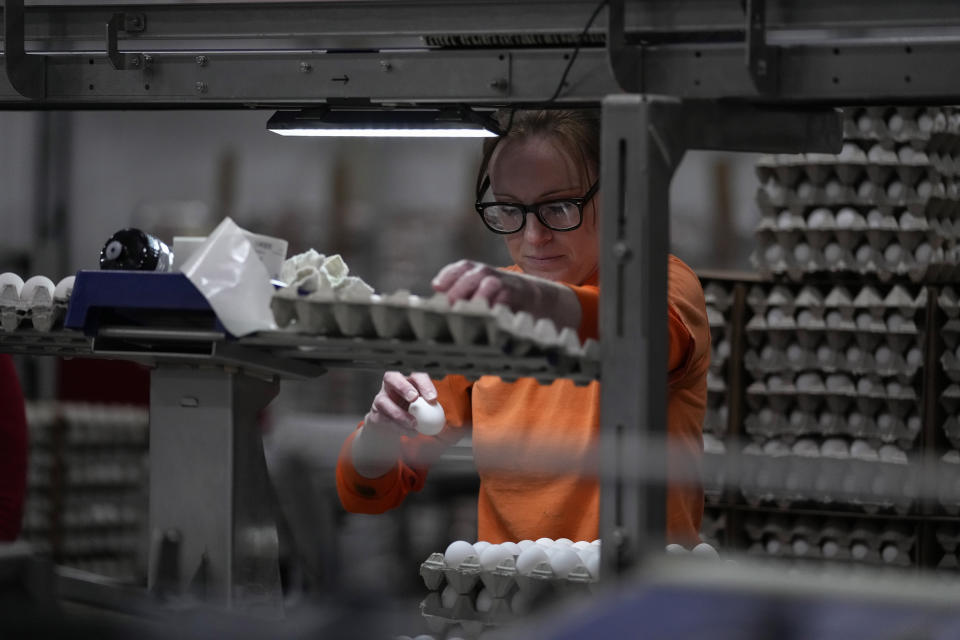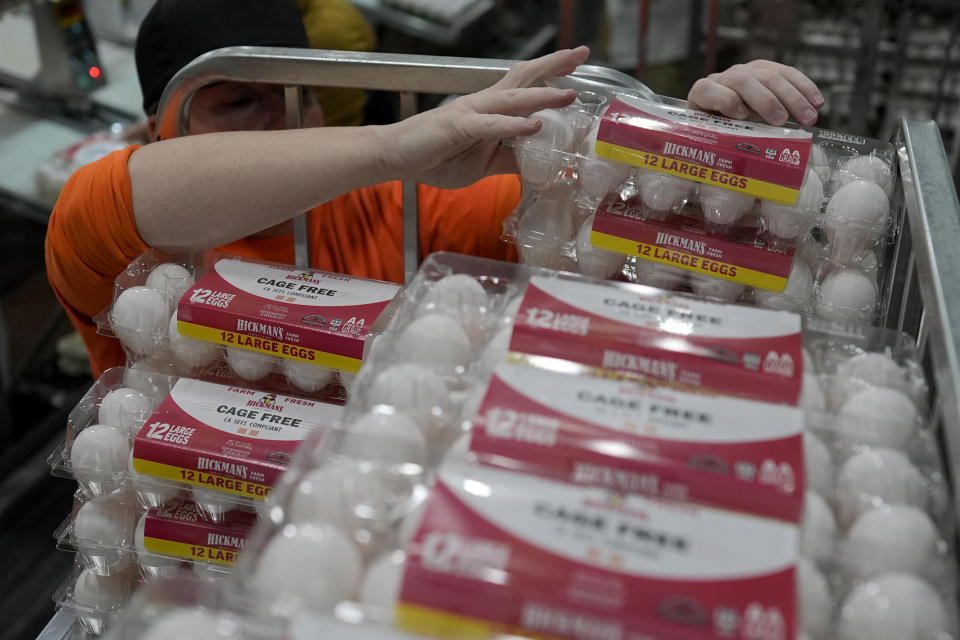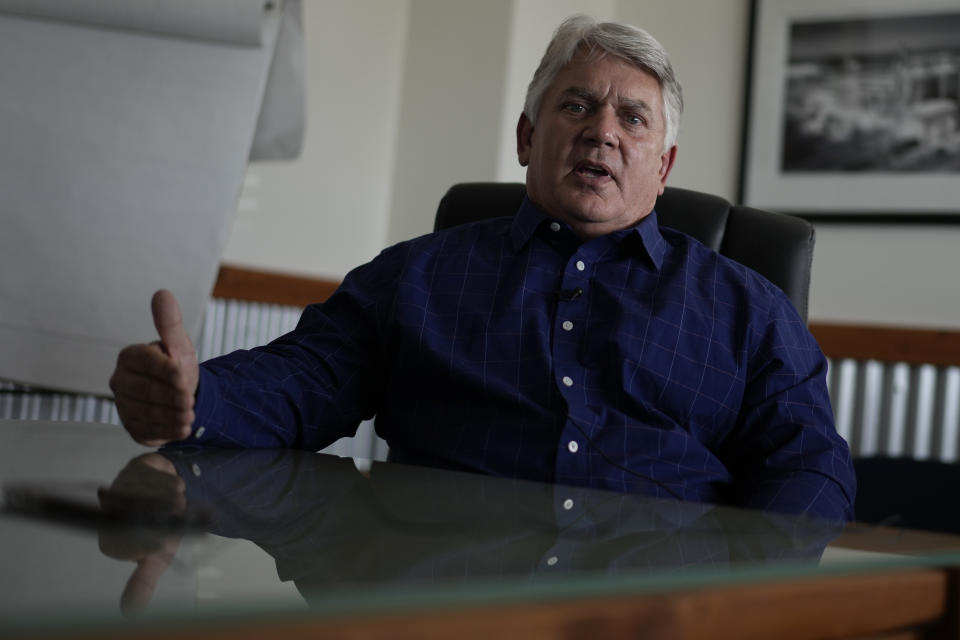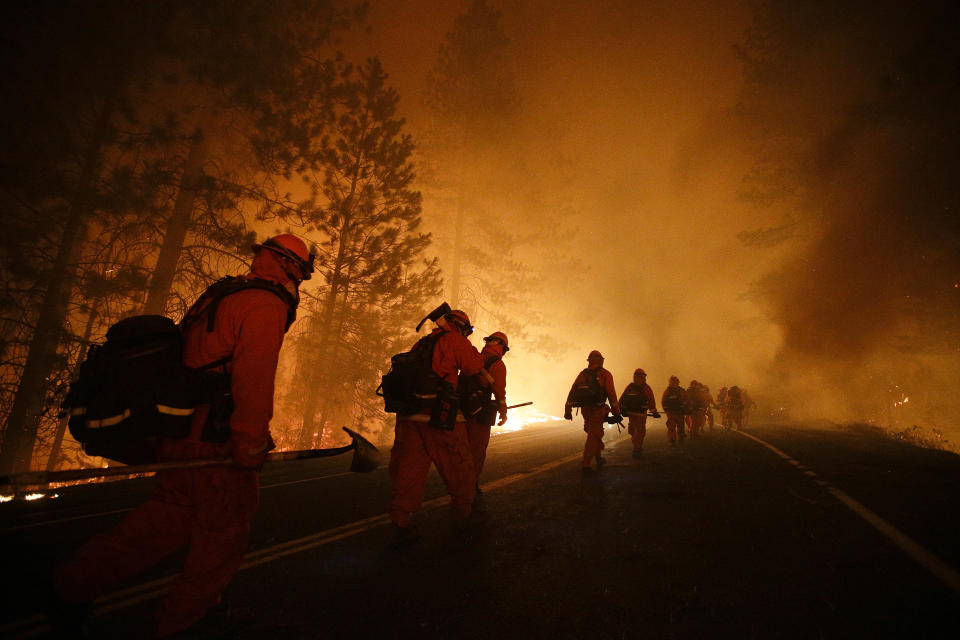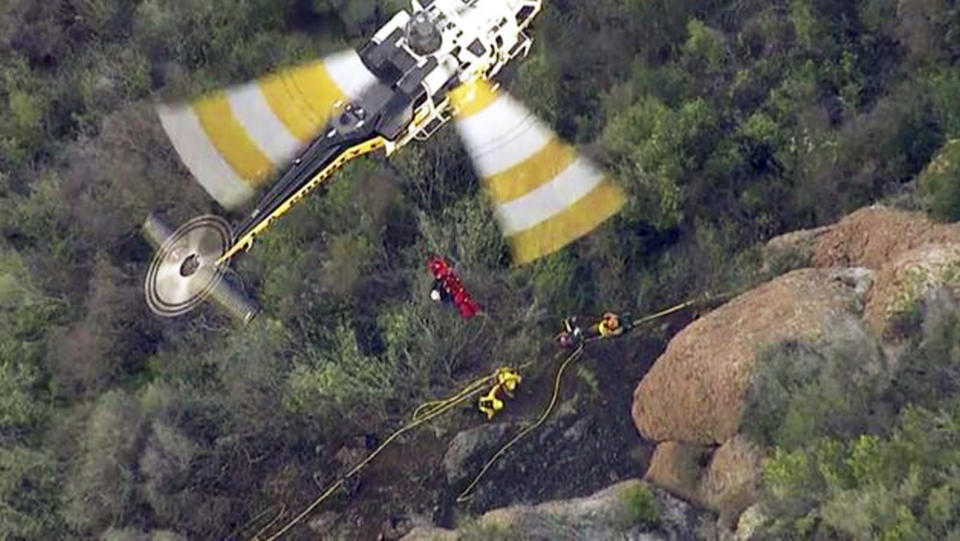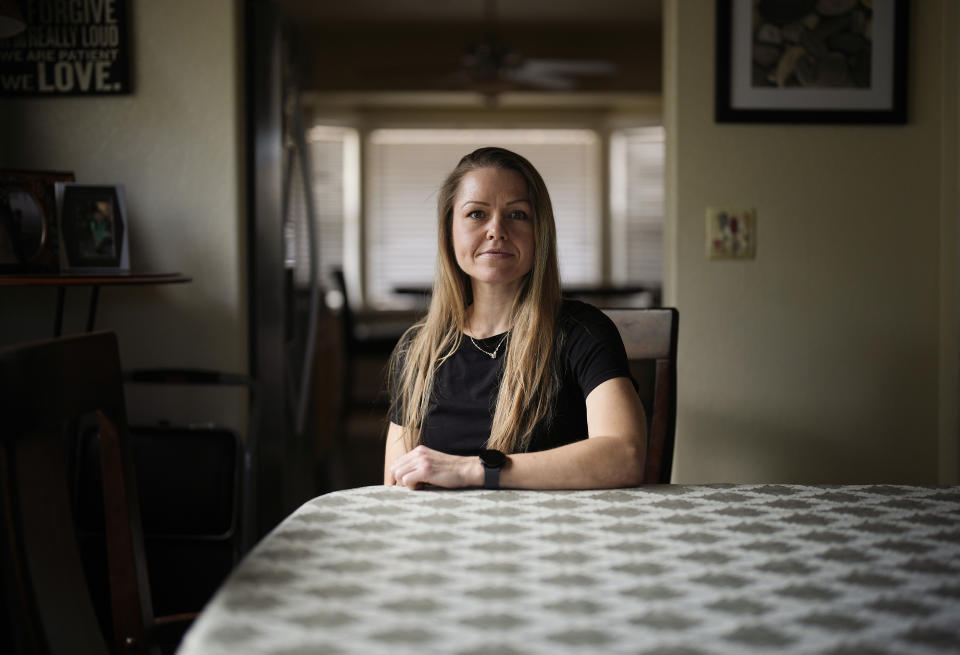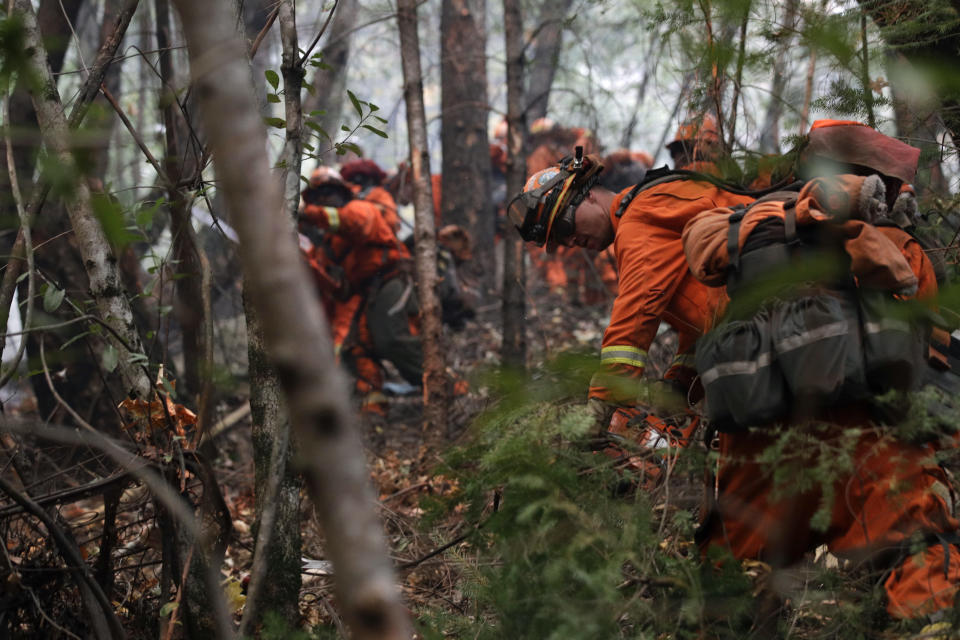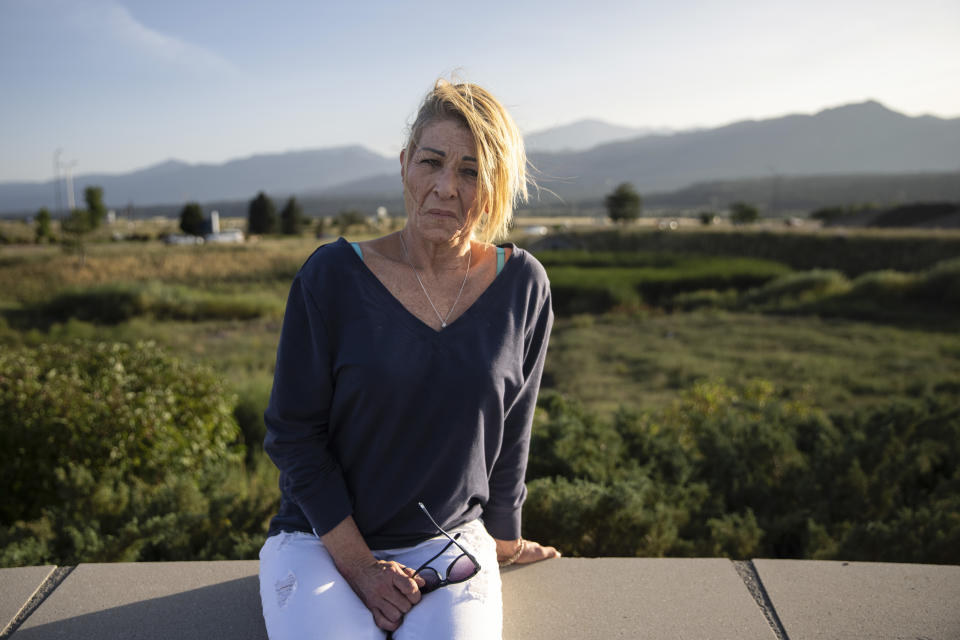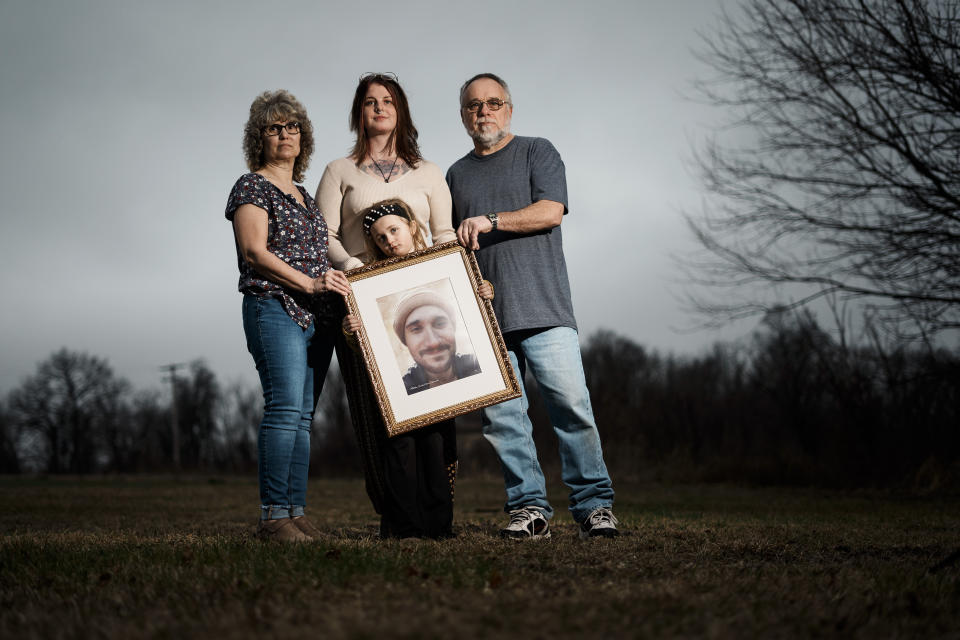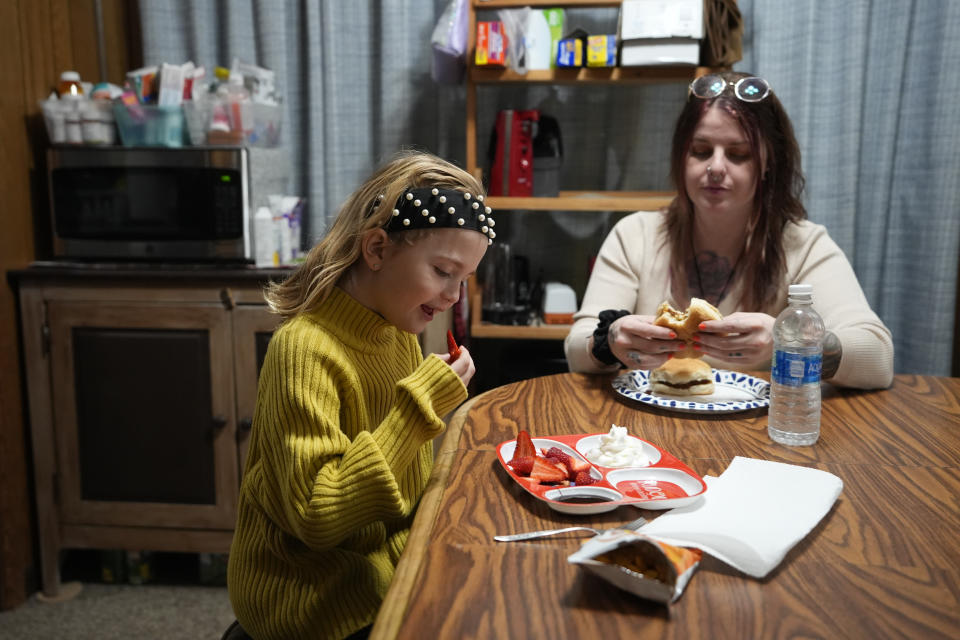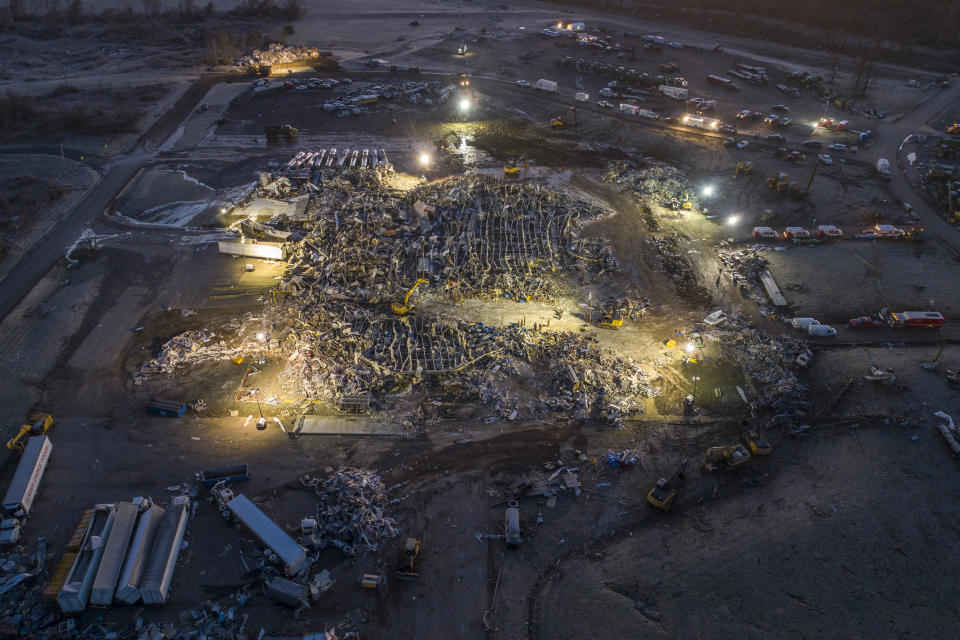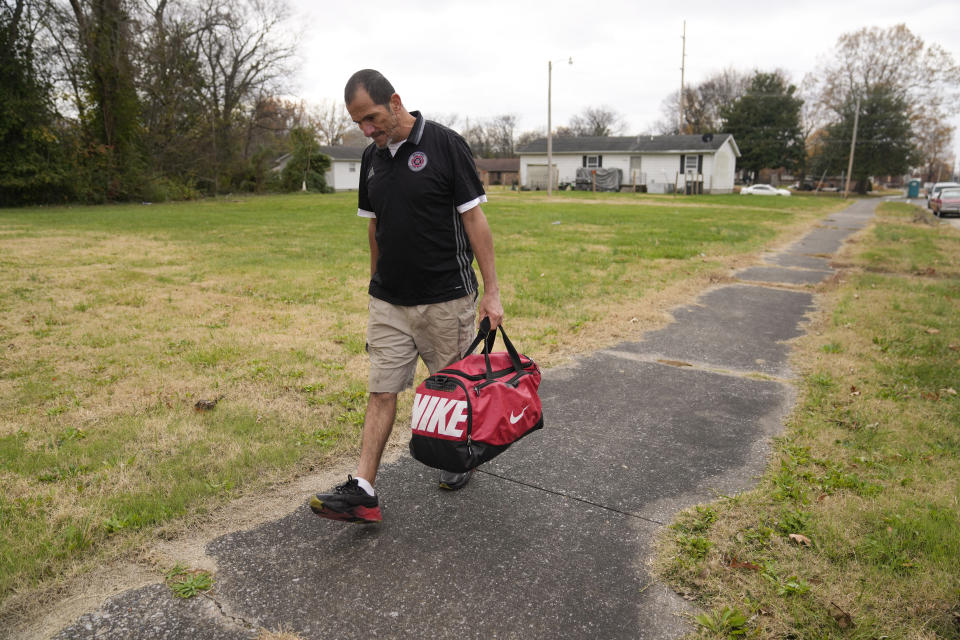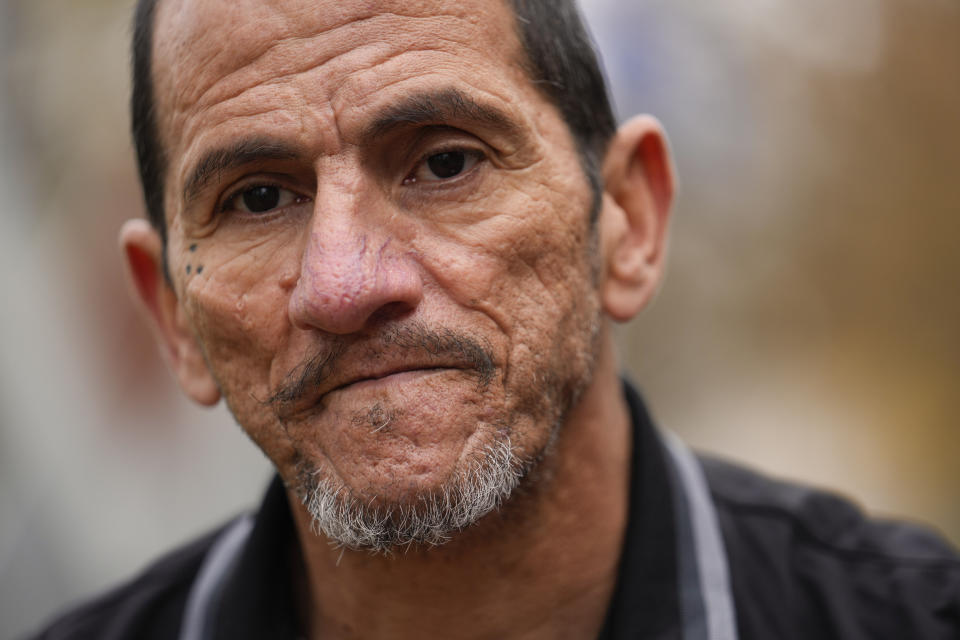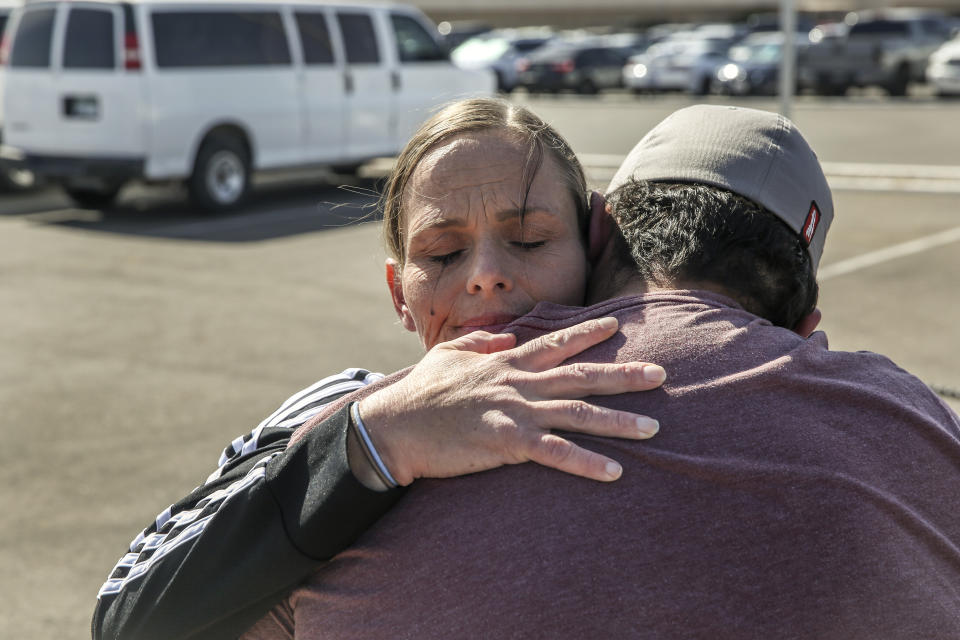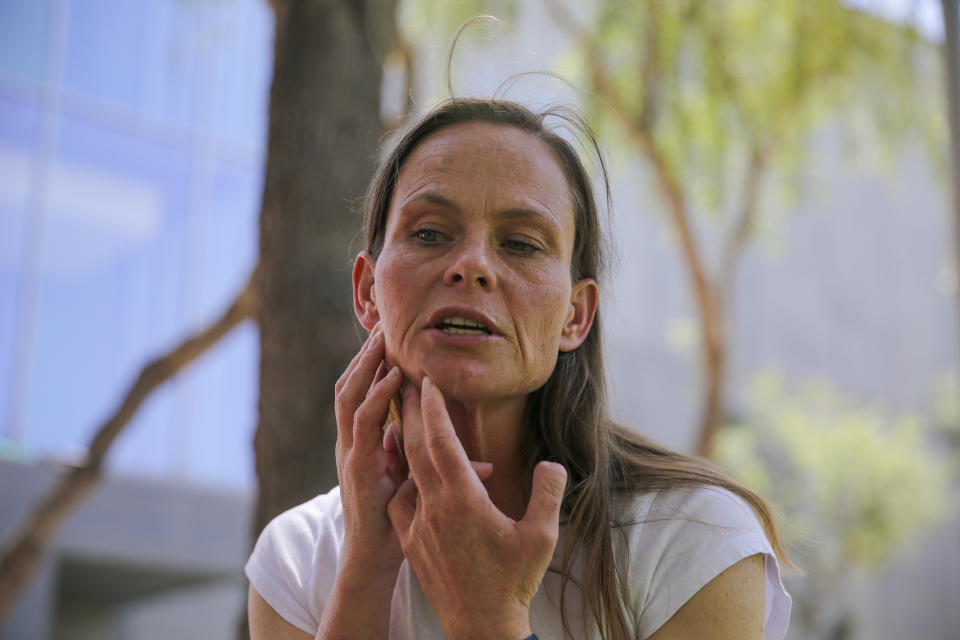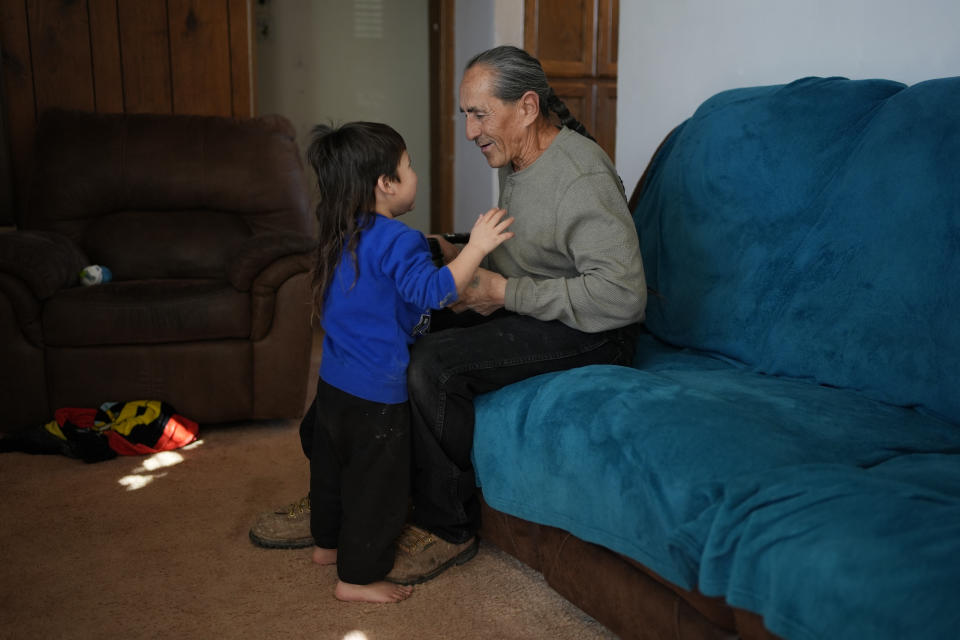US prisoners are being assigned dangerous jobs. But what happens if they are hurt or killed?
- Oops!Something went wrong.Please try again later.
- Oops!Something went wrong.Please try again later.
PHOENIX (AP) — Blas Sanchez was nearing the end of a 20-year stretch in an Arizona prison when he was leased out to work at Hickman’s Family Farms, which sells eggs that have ended up in the supply chains of huge companies like McDonald’s, Target and Albertsons. While assigned to a machine that churns chicken droppings into compost, his right leg got pulled into a chute with a large spiraling augur.
“I could hear ‘crunch, crunch, crunch, crunch,’” Sanchez said. “I couldn’t feel anything, but I could hear the crunch.”
He recalled frantically clawing through mounds of manure to tie a tourniquet around his bleeding limb. He then waited for what felt like hours while rescuers struggled to free him so he could be airlifted to a hospital. His leg was amputated below the knee.
Nationwide, hundreds of thousands of prisoners are put to work every year, some of whom are seriously injured or killed after being given dangerous jobs with little or no training, The Associated Press found. They include prisoners fighting wildfires, operating heavy machinery or working on industrial-sized farms and meat-processing plants tied to the supply chains of leading brands. These men and women are part of a labor system that – often by design – largely denies them basic rights and protections guaranteed to other American workers.
The findings are part of a broader two-year AP investigation that linked some of the world’s largest and best-known companies – from Cargill and Walmart to Burger King – to prisoners who can be paid pennies an hour or nothing at all.
Prison labor began during slavery and exploded as incarceration rates soared, disproportionately affecting people of color. As laws have steadily changed to make it easier for private companies to tap into the swelling captive workforce, it has grown into a multibillion-dollar industry that operates with little oversight.
Laws in some states spell it out clearly: Prisoners aren’t classified as employees, whether they’re working inside correctional facilities or for outside businesses through prison contracts or work-release programs. That can exclude them from workers’ compensation benefits, along with state and federal laws that set minimum standards for health and safety on the job.
It’s almost impossible to know how many incarcerated workers are hurt or killed each year, partly because they often don’t report injuries, fearing retaliation or losing privileges like contact with their families. Privacy laws add to the challenges of obtaining specific data. In California, for instance, more than 700 work-related injuries were recorded between 2018 and 2022 in the state’s prison industries program, but the documents provided to the AP were heavily redacted.
At Hickman’s Family Farms, logs obtained by the AP from Arizona’s corrections department listed about 250 prison worker injuries during the same time frame. Most were minor, but some serious cases ranged from deep cuts and sliced-off fingertips to smashed hands.
“They end up being mangled in ways that will affect them for the rest of their lives,” said Joel Robbins, a lawyer who has represented several prisoners hired by Hickman’s. “If you’re going to come out with a good resume, you should come out with two hands and two legs and eyes to work.”
The AP requested comment from the companies it identified as having connections to prison labor. Most did not respond, but Cargill -- the largest private company in the U.S. with $177 billion in revenue last year -- said it was continuing to work “to ensure there is no prison labor in our extended supplier network.” Others said they were looking for ways to take action without disrupting crucial supply chains.
Prisoners across the country can be sentenced to hard labor, forced to work and punished if they refuse, including being sent to solitary confinement. They cannot protest against poor conditions, and it’s usually difficult for them to sue.
Most jobs are inside prisons, where inmates typically earn a few cents an hour doing things like laundry and mopping floors. The limited outside positions often pay minimum wage, but some states deduct up to 60% off the top.
In Arizona, jobs at Hickman’s are voluntary and often sought after, not just for the money, but also because employment and affordable housing are offered upon release.
During a daylong guided tour of the company’s egg-packaging operations and housing units, two brothers who run the family business stressed to an AP reporter that safety and training are top priorities. Several current and formerly incarcerated workers there praised the company, which markets eggs with brand names like Land O’ Lakes, Eggland’s Best and Hickman’s, and have been sold everywhere from Safeway to Kroger.
“We work on a farm with machinery and live animals, so it is important to follow the instructions,” said Ramona Sullins, who has been employed by Hickman’s for more than eight years before and after her release from prison. “I have heard and seen of people being hurt, but when they were hurt, they weren’t following the guidelines.”
AP reporters spoke with more than 100 current and former prisoners across the country – along with family members of workers who were killed – about various prison labor jobs. Roughly a quarter of them related stories involving injuries or deaths, from severe burns and traumatic head wounds to severed body parts. Reporters also talked to lawyers, researchers and experts, and combed through thousands of documents, including the rare lawsuits that manage to wind their way through the court system.
While many of the jobs are hidden, others are in plain view, like prisoners along busy highways doing road maintenance. In Alabama alone, at least three men have died since 2015, when 21-year-old Braxton Moon was hit by a tractor-trailer that swerved off the interstate. The others were killed while picking up trash.
In many states, laws mandate that prisoners be deployed during emergencies and disasters for jobs like hazardous material cleanup or working on the frontlines of hurricanes while residents evacuate. They’re also sent to fight fires, filling vital worker shortage gaps, including in some rural communities in Georgia where incarcerated firefighters are paid nothing as the sole responders for everything from car wrecks to medical emergencies.
California currently has about 1,250 prisoners trained to fight fires and has used them since the 1940s. It pays its “Angels in Orange” $2.90 to $5.12 a day, plus an extra $1 an hour when they work during emergencies.
When a brush fire broke out in 2016, Shawna Lynn Jones and her crew were sent to the wealthy Malibu beach community near California’s rugged Pacific Coast Highway, which was built by prisoners a century ago. The 22-year-old, who had just six weeks left on her sentence for a nonviolent crime, died after a boulder fell 100 feet from a hillside onto her head – one of 10 incarcerated firefighters killed in the state since 1989.
Unlike many places, California does offer workers’ compensation to prisoners, which Jones’ mother, Diana Baez, said covered hospital expenses and the funeral.
Baez said her daughter loved being a firefighter and was treated as a fallen hero, but noted that even though she was on life support and never regained consciousness, “When I walked behind the curtain, she was still handcuffed to that damn gurney.”
The California corrections department said prisoners must pass a physical skills test to participate in the program, which “encourages incarcerated people to commit to positive change and self-improvement.” But inmates in some places across the country find it can be extremely difficult to transfer their firefighting skills to outside jobs upon their release due to their criminal records.
In most states, public institutions are not liable for incarcerated workers’ injuries or deaths. But in a case last year, the American Civil Liberties Union represented a Nevada crew sent to mop up a wildfire hotspot. It resulted in a $340,000 settlement that was split eight ways, as well as assurances of better training and equipment going forward.
Rebecca Leavitt said when she and her all-woman team arrived at the site with only classroom training, they did a “hot foot dance” on smoldering embers as their boss yelled “Get back in there!” One crew member’s burned-up boots were duct-taped back together, she said, while others cried out in pain as their socks melted to their feet during nine hours on the ground that paid about $1 an hour.
Two days later, Leavitt said the women finally were taken to an outside hospital, where doctors carved dead skin off the bottoms of their feet, which had sustained second-degree burns. Because they were prisoners, they were denied pain medicine.
“They treated us like we were animals or something,” said Leavitt, adding that the women were afraid to disobey orders in the field or report their injuries for fear they could be sent to a higher-security facility. “The only reason why any of us had to tell them was because we couldn’t walk.”
Officials at Nevada’s Department of Corrections did not respond to requests for comment.
Chris Peterson, the ACLU lawyer who brought the women’s lawsuit, said Nevada’s Legislature has passed laws making it harder for injured prisoners to receive compensation. He noted that the state Supreme Court ruled five years ago that an injured firefighter could receive the equivalent of only about 50 cents a day in workers’ compensation based on how much he earned in prison, instead of the set minimum wage.
“At the end of the day,” Peterson said, “the idea is that if I get my finger lopped off, if I am an incarcerated person working as a firefighter, I am entitled to less relief than if I am a firefighter that’s not incarcerated.”
“HELP ME! HELP ME!”
A loophole in the 13th Amendment to the U.S. Constitution passed after the Civil War makes forced labor legal, abolishing slavery except “as punishment for a crime.” Efforts are underway to challenge that language at the federal level, and nearly 20 states are working to bring the issue before voters.
Today, about 2 million people are locked up in the U.S. – more than almost any country in the world – a number that began spiking in the 1980s when tough-on-crime laws were passed. More than 800,000 prisoners have some kind of job, from serving food inside facilities to working outside for private companies, including work-release assignments everywhere from KFC to Tyson Foods poultry plants. They’re also employed at state and municipal agencies, and at colleges and nonprofit organizations.
Few critics believe all prison jobs should be eliminated, but they say work should be voluntary and prisoners should be fairly paid and treated humanely. Correctional officials and others running work programs across the country respond that they place a heavy emphasis on training and that injuries are taken seriously. Many prisoners see work as a welcome break from boredom and violence inside their facilities and, in some places, it can help shave time off sentences.
In many states, prisoners are denied everything from disability benefits to protections guaranteed by the federal Occupational Safety and Health Administration or state agencies that ensure safe conditions for laborers. In Arizona, for instance, the state occupational safety division doesn’t have the authority to pursue cases involving inmate deaths or injuries.
Strikes by prisoners seeking more rights are rare and have been quickly quashed. And the U.S. Supreme Court has ruled that inmates cannot join or form unions. They also can’t call an ambulance or demand to be taken to a hospital, even if they suffer a life-threatening injury on the job.
The barriers for those who decide to sue can be nearly insurmountable, including finding a lawyer willing to take the case. That’s especially true after the federal Prison Litigation Reform Act was passed almost three decades ago to stem a flood of lawsuits that accompanied booming prison populations.
Kandy Fuelling learned that all too well after being gravely injured in 2015 while assigned to work at a Colorado sawmill. She said her lawyer never met with her face-to-face and her suit was dismissed after a court ruled she could not sue state entities, leaving her with zero compensation.
Fuelling, who said she received only a few hours of training at the Pueblo mill, was feeding a conveyor belt used to make pallets when a board got stuck. She said she asked another prisoner if the machinery was turned off, but was told by her manager to “hurry up” and dislodge the jam. She crawled under the equipment and tugged at a piece of splintered lumber. Suddenly, the blade jolted back to life and spiraled toward her head.
“That saw went all the way through my hard hat. … I’m screaming ‘Help me! Help me!’ but no one can hear me because everything is running,” Fuelling said. “All I remember is thinking, ‘Oh my God, I think it just cut my head off.’”
With no first aid kit available, fellow prisoners stuck sanitary pads on her gushing wound and ushered her into a van. But instead of being driven to a nearby emergency room, she was taken to the prison for evaluation. The 5-inch gash, which pierced her skull, eventually was sewn up at an outside hospital.
Despite being dizzy and confused, she said she was put back to work soon after in the prison’s laundry room and received almost no treatment for months, even when her wound oozed green pus. She said she had privileges stripped and eventually was diagnosed with MRSA, an antibiotic-resistant infection. She still suffers short-term memory loss and severe headaches, she said.
The Colorado Department of Corrections had no comment when asked about prisoner training and medical treatment for those injured on the job.
While prisoners have access to low-cost care in correctional facilities nationwide, a typical co-pay of $2 to $5 per visit can be unaffordable for those earning next to nothing. Many inmates say it’s not worth it because the care they receive is often so poor.
Class-action lawsuits have been filed in several states – including Illinois, Idaho, Delaware and Mississippi – alleging everything from needless pain and suffering to deliberate medical neglect and lack of treatment for diseases like hepatitis C.
Some prisoners’ conditions worsened even after getting care for their injuries.
In Georgia, a prison kitchen worker’s leg was amputated after he fell on a wet floor, causing a small cut above his ankle. He was susceptible to infection as a diabetic, but doctors in the infirmary did not stop the wound from festering, according to a lawsuit that was handwritten and filed by the prisoner. It was an unusual case where the state settled – for $550,000 – which kept the prison medical director from going to trial.
Noah Moore, who lost a finger while working at Hickman’s egg farm in Arizona, had a second finger later amputated due to what he said was poor follow-up treatment in prison after surgery at a hospital. That’s in a state where a federal judge ruled two years ago that the prison medical care was unconstitutional and “plainly, grossly inadequate.”
“I think the healing hurt worse than the actual accident,” Moore said.
The Arizona corrections department would not comment on injuries that occurred during a previous administration, but said prisoners have access to all necessary medical care. The department also stressed the importance of workplace safety training.
Prisons and jails can struggle to find doctors willing to accept jobs, which means they sometimes hire physicians who have been disciplined for misconduct.
A doctor in Louisiana, Randy Lavespere, served two years in prison after buying $8,000 worth of methamphetamine in a Home Depot parking lot in 2006 with intent to distribute. After his release, his medical license was reinstated with restrictions that banned him from practicing in most settings. Still, he was hired by the Louisiana State Penitentiary, the country’s largest maximum-security prison. His license has since been fully reinstated, and he now oversees health care for the entire corrections department.
Over the years, physicians who have worked at Louisiana prisons have had their medical licenses restricted or suspended following offenses ranging from sexual misconduct and possessing child pornography to self-prescribing addictive drugs, according to the state Board of Medical Examiners.
Lavespere could not be reached for comment, but corrections department spokesman Ken Pastorick said all prison doctors are licensed and that the board does not allow physicians to return to work unless they are “deemed competent and have the ability to practice medicine with skill and safety.”
NO REMEDY FOR HARM
Across the country, it’s not uncommon for the relatives of prisoners who died on the job to struggle with determining who’s liable. When workers’ compensation is offered, the amount awarded is typically determined by the size of the worker’s paycheck and usually closes the door on future wrongful death suits.
The few cases that make their way to court can result in meager settlements compared to what the survivors of civilian workers might receive, in part because those behind bars are seen as having little or no future earning potential.
Matthew Baraniak was on work release in 2019 when he was killed at a Pennsylvania heavy machinery service center while operating a scissor lift. He was using a high-heat torch on a garbage truck that was rigged precariously with chains when its weight shifted, causing Baraniak to hit his head and lose control of the burning torch. His body was engulfed in flames.
Ashley Snyder, the mother of Baraniak’s daughter, accepted a workers’ comp offer made to benefit their then 3-year-old child, paying about $700 a month until the girl reaches college age. Family members said their claim against the county running the work-release program was dismissed, and their lawyer told them the best they could hope for was a small settlement from the service center.
“There are no rules,” Holly Murphy, Baraniak’s twin sister, said of the long and confusing process. “It’s just a gray area with no line there that says what’s acceptable, what the laws are.”
Michael Duff, a law professor at Saint Louis University and an expert on labor law, said some people think, “Well, too bad, don’t be a prisoner.” But an entire class of society is being denied civil rights, Duff said, noting that each state has its own system that could be changed to offer prisoners more protections if there’s political will.
“We’ve got this category of human beings that can be wrongfully harmed and yet left with no remedy for their harm,” he said.
Laws sometimes are amended to create even more legal hurdles for those seeking relief.
That’s what happened in Arizona. In 2021, a Hickman’s Family Farms lawyer unsuccessfully tried to get the corrections department to amend its contract to take responsibility for prisoner injuries or deaths, according to emails obtained by the AP. The next year, a newly formed nonprofit organization lobbied for a bill that was later signed into law, blocking prisoners from introducing their medical costs into lawsuits and potentially limiting settlement payouts.
Billy Hickman, one of the siblings who runs the egg company, was listed as a director of the nonprofit. He told the AP that the farm has hired more than 10,000 incarcerated workers over nearly three decades. Because they aren’t eligible for protections like workers’ comp, he said the company tried to limit its exposure to lawsuits partially driven by what he described as zealous attorneys.
“We’re a family business,” he said, “so we take it very seriously that people are safe and secure.”
At the height of the pandemic – when all other outside prison jobs were shut down – Crystal Allen and about 140 other female prisoners were sent to work at Hickman’s, bunking together in a large company warehouse. The egg farm is Arizona Correctional Industries’ biggest customer, bringing in nearly $35 million in revenue in the past six fiscal years.
Allen was earning less than $3 an hour after deductions, including 30% for room and board. She knew it would take time, but hoped to bank a few thousand dollars before her release.
One day, she noticed chicken feeders operating on a belt system weren’t working properly, so she switched the setting to manual and used her hand to smooth the feed into place.
“All of a sudden, the cart just takes off with my thumb,” said Allen, adding she had to use her sock to wrap up her left hand, which was left disfigured. “It’s bleeding really, really bad.”
She sued before the new state law took effect and settled with the company last year for an undisclosed amount. In legal filings, Hickman’s denied any wrongdoing.
THE PAIN LIVES ON
When a 2021 tornado flattened a Kentucky factory that made candles for Bath & Body Works and other major companies, Marco Sanchez risked his life to pull fellow employees from the debris. Eight people were killed, including the correctional officer overseeing Sanchez and other prisoners on a work-release program.
Sanchez fractured ribs and broke his foot and, after being treated at a hospital, was taken to the Christian County Jail. According to an ongoing civil rights lawsuit filed last year, he was sent to solitary confinement there and beaten by guards frustrated by his repeated requests for medical attention, which he said went unmet.
“They were retaliating against me,” said Sanchez , who was homeless when he talked to the AP. “They were telling me, ‘It should have been you … instead of one of ours.’”
Christian County Jail officials would not comment, citing the pending litigation. But attorney Mac Johns, who is representing the correctional officers, disputed Sanchez’s characterization of the care and treatment he received while incarcerated, without elaborating.
A few months after the tornado, Sanchez was portrayed on national television as a hero and given a key to the city, but he questions why he was treated differently than the civilian workers he was employed alongside.
He noted that they got ongoing medical attention and support from their family members at a difficult time. “I didn’t get that,” he said, adding that strong winds and sirens still leave him cowering.
The man who lost his leg while working at the composting chute in Arizona said he, too, continues to struggle, even though nearly a decade has passed since the accident.
Blas Sanchez settled for an undisclosed amount with Hickman’s, which denied liability in court documents. He now runs a motel in Winslow along historic U.S. Route 66 and said he’s still often in agony – either from his prosthetic or shooting pains from the nerves at the end of his severed limb.
And then there’s the mental anguish. Sometimes, he wonders if continuing to live is worth it.
“I wanted to end it because it’s so tiring and it hurts. And if it wasn’t for these guys, I probably would,” he said, motioning to his step-grandchildren playing around him. “End it. Finished. Done. Buried.”
—-
The Associated Press receives support from the Public Welfare Foundation for reporting focused on criminal justice. This story also was supported by Columbia University’s Ira A. Lipman Center for Journalism and Civil and Human Rights in conjunction with Arnold Ventures. The AP is solely responsible for all content.
——
Contact AP’s global investigative team at Investigative@ap.org or https://www.ap.org/tips/
